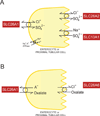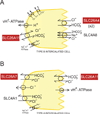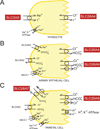The SLC26 gene family of anion transporters and channels
- PMID: 23506885
- PMCID: PMC3602804
- DOI: 10.1016/j.mam.2012.07.009
The SLC26 gene family of anion transporters and channels
Abstract
The phylogenetically ancient SLC26 gene family encodes multifunctional anion exchangers and anion channels transporting a broad range of substrates, including Cl(-), HCO3(-), sulfate, oxalate, I(-), and formate. SLC26 polypeptides are characterized by N-terminal cytoplasmic domains, 10-14 hydrophobic transmembrane spans, and C-terminal cytoplasmic STAS domains, and appear to be homo-oligomeric. SLC26-related SulP proteins of marine bacteria likely transport HCO3(-) as part of oceanic carbon fixation. SulP genes present in antibiotic operons may provide sulfate for antibiotic biosynthetic pathways. SLC26-related Sultr proteins transport sulfate in unicellular eukaryotes and in plants. Mutations in three human SLC26 genes are associated with congenital or early onset Mendelian diseases: chondrodysplasias for SLC26A2, chloride diarrhea for SLC26A3, and deafness with enlargement of the vestibular aqueduct for SLC26A4. Additional disease phenotypes evident only in mouse knockout models include oxalate urolithiasis for Slc26a6 and Slc26a1, non-syndromic deafness for Slc26a5, gastric hypochlorhydria for Slc26a7 and Slc26a9, distal renal tubular acidosis for Slc26a7, and male infertility for Slc26a8. STAS domains are required for cell surface expression of SLC26 proteins, and contribute to regulation of the cystic fibrosis transmembrane regulator in complex, cell- and tissue-specific ways. The protein interactomes of SLC26 polypeptides are under active investigation.
Copyright © 2012 Elsevier Ltd. All rights reserved.
Figures






References
Publication types
MeSH terms
Substances
Grants and funding
LinkOut - more resources
Full Text Sources
Other Literature Sources
Medical
Molecular Biology Databases

